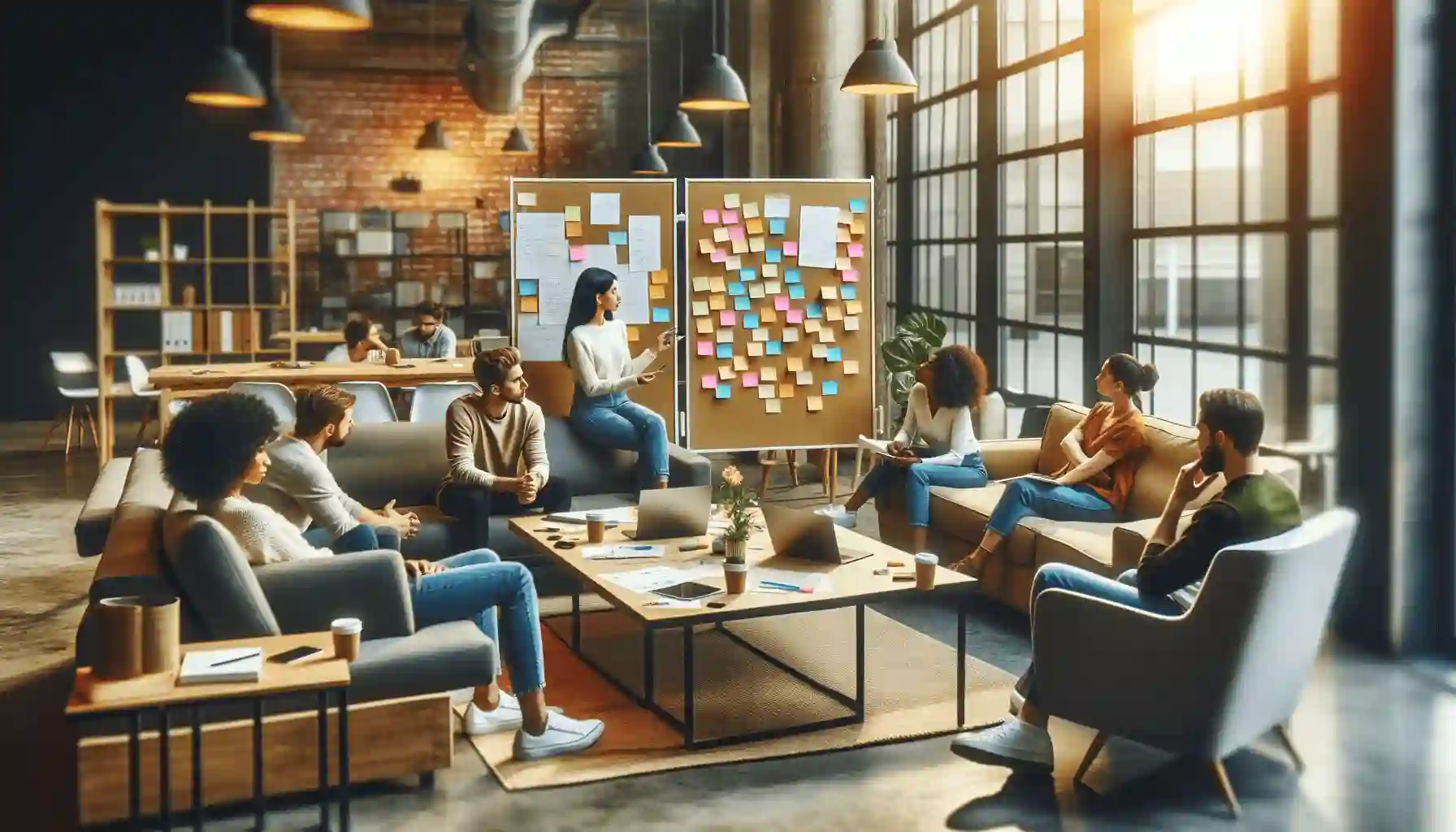Leadership Meeting
This guide will walk you through the essential elements of use leadership meeting to keep your attendees aligned and engaged.
Try Lark for Free
In the ever-changing landscape of modern business, the ability to effectively conduct leadership meetings is crucial for success. Leadership meetings provide a platform for strategic discussions, decision-making, and aligning organizational objectives. When executed adeptly, these meetings can steer a company towards its goals and foster a culture of collaboration and innovation. This guide will offer comprehensive insights and practical tips to help leaders orchestrate successful leadership meetings in 2024, ensuring maximum productivity and tangible outcomes.
Use Lark Meetings to turn meetings into true collaborative experiences.
What is a leadership meeting?
A leadership meeting is a designated gathering where key decision-makers within an organization convene to discuss crucial matters, align strategies, and make important decisions. These meetings are pivotal in shaping the direction of the company, ensuring that key stakeholders are aligned and informed about the organization's goals and initiatives. While the exact composition and structure may vary, leadership meetings typically involve the top-level executives, department heads, and other influential figures within the organization. Effective leadership meetings drive strategic alignment, foster communication, and promote a shared vision for the organization.
Goals of leadership meeting
The primary goals of a leadership meeting are multi-faceted. Here are the key objectives:
- Strategic Alignment: Ensuring that all participants are aligned with the organization's strategic goals and priorities.
- Decision-Making: Facilitating informed and decisive choices on critical matters affecting the organization.
- Communication: Providing a platform for transparent and open communication among leadership members.
- Team Building: Fostering relationships and collaboration among the leadership team.
The overarching aim is to drive the organization forward by leveraging the collective expertise and perspectives of the leadership team. The success of a leadership meeting is often measured by the extent to which these goals are achieved.
Who should attend a leadership meeting?
The composition of a leadership meeting is crucial for its effectiveness. Typically, the following individuals should be present at such meetings:
- C-Suite Executives: Including the CEO, CFO, COO, and other relevant executives.
- Senior Management: Department heads and senior managers responsible for strategic decision-making.
- External Advisors or Consultants: In certain cases, external experts or consultants might be invited to provide specialized insights.
Striking a balance between having the right expertise and not overcrowding the meeting is essential. The attendance of the right individuals ensures that the meeting achieves its intended objectives.
Learn more about Lark x Meetings
Topics, agenda, and structure of leadership meeting
The agenda and structure of a leadership meeting are critical components that dictate its effectiveness. Some elements to consider include:
- Strategic Discussions: Addressing the overarching vision, long-term goals, and competitive positioning of the organization.
- Operational Updates: Reviewing the current state of affairs, analyzing performance metrics, and identifying areas for improvement.
- Critical Decision Points: Identifying and addressing key decisions that require input or consensus from the leadership team.
- Actionable Takeaways: Ensuring that the meeting concludes with clearly defined action items and responsibilities.
The agenda should be meticulously crafted to optimize time and deliver maximum value. A well-structured agenda ensures that the meeting stays on track and covers all pertinent topics.
Learn more about Lark x Meetings
How often does a leadership meeting occur?
The frequency of leadership meetings often depends on the nature and needs of the organization. While some companies conduct these meetings on a quarterly basis, others may opt for bi-annual or even monthly gatherings. The key is to find a cadence that allows for timely strategic reviews and decision-making without overwhelming the leadership team with excessive meetings. Ultimately, the frequency should support the organization's strategic planning and operational needs.
Key differences between leadership meetings and another similar meeting
While leadership meetings may share similarities with other types of corporate gatherings, their distinguishing features lie in their:
- Strategic Focus: Leadership meetings primarily revolve around high-level, strategic discussions and decision-making.
- Executive Attendance: They involve the topmost levels of leadership and decision-makers within the organization.
- Organizational Impact: The outcomes of leadership meetings often have substantive implications for the overall direction and performance of the company.
Understanding these differences is crucial in ensuring that the right individuals are engaged and that the discussions remain strategically focused.
Learn more about Lark x Meetings
Three practical examples of leadership meetings
Example 1: annual strategy alignment
Example 1: annual strategy alignment
In this scenario, the leadership meeting is dedicated to aligning the company's overall strategic direction for the forthcoming year. Discussions may revolve around market conditions, competitive positioning, and key initiatives.
Example 2: new product launch
Example 2: new product launch
Leadership meetings play a pivotal role in aligning the launch strategy, addressing potential challenges, and ensuring that the launch aligns with the overall business objectives.
Example 3: crisis management and adaptation
Example 3: crisis management and adaptation
During times of crisis or rapid change, leadership meetings are instrumental in formulating an agile response, making critical decisions, and aligning the organization's efforts towards resilience and adaptability.
Common pitfalls of a leadership meeting
Leadership meetings, while essential, can encounter several pitfalls that hinder their efficacy. Some common challenges include:
- Lack of Clear Objectives: Meetings without well-defined objectives can lead to aimless discussions and indecisiveness.
- Dominating Personalities: Overbearing voices can stifle participation and hinder the free flow of ideas within the group.
- Overwhelming Agendas: A packed agenda with too many topics can lead to superficial discussions and hasty decision-making.
Understanding and mitigating these pitfalls is crucial for ensuring that leadership meetings are productive and meaningful.
Learn more about Lark x Meetings
Dos and don’ts of a leadership meeting
| Do's | Don'ts |
|---|---|
| Clearly define meeting objectives | Overloading the agenda |
| Encourage active participation | Dominating the discussion |
| Set actionable follow-ups | Ignoring diverse perspectives |
| Respect time and punctuality | Disregarding pre-reading materials |
| Foster a collaborative environment | Allowing distractions |
Adhering to these dos and don’ts can significantly enhance the productivity and effectiveness of leadership meetings.
What makes a virtual leadership meeting succeed?
In an increasingly digital world, virtual leadership meetings have become more prevalent. Factors that contribute to the success of such meetings include:
- Reliable Technology: Ensuring that the virtual platform is stable, secure, and user-friendly.
- Engagement Tools: Utilizing interactive features to foster engagement and participation among attendees.
- Clear Communication Protocols: Establishing guidelines for virtual interactions to minimize misunderstanding and non-verbal cues.
Virtual leadership meetings require deliberate planning and consideration to ensure that they are as productive as their physical counterparts.
Related:
Unlock the Power of Webinars: A Comprehensive Guide to Boost Your Business | Lark Blog | Lark BlogLearn more about Lark x Meetings
Typical takeaways of the leadership meeting
Following a well-executed leadership meeting, the typical takeaways include:
- Strategic Alignment: Consensus and alignment among leadership members on key strategic initiatives.
- Actionable Insights: Clear insights and decisions on critical matters affecting the organization.
- Defined Action Items: Agreed-upon action items and responsibilities with clear timelines for execution.
These takeaways are instrumental in driving the organization forward and ensuring that the meeting yields tangible outcomes.
Questions to ask in the leadership meeting
During a leadership meeting, asking the right questions is critical for driving productive discussions and decision-making. Some key questions to consider include:
- What are the potential risks and opportunities in the current market landscape?
- How can our organization enhance its competitive positioning in the industry?
- What strategic initiatives should we prioritize in the upcoming quarter/year?
- Are there areas within the organization that require immediate attention or realignment?
- How can we leverage our resources more effectively to drive growth and innovation?
Asking incisive and relevant questions can stimulate insightful dialogue and result in informed decisions.
Learn more about Lark x Meetings
Conclusion
In conclusion, mastering the art of conducting successful leadership meetings in 2024 is foundational to an organization's progress and prosperity. By strategically curating agendas, fostering open communication, and adhering to best practices, leaders can optimize these meetings to drive strategic alignment, foster collaboration, and propel the organization towards its objectives. Embracing the evolving dynamics of virtual meetings while upholding the essential principles of effective leadership gatherings will ensure that organizations leverage these pivotal events to their fullest potential.
Q&a
Common Concerns About Leadership Meetings
How can a leader ensure participation from all members during a leadership meeting?
To secure active participation, leaders can:
- Set Clear Expectations: Communicate the meeting's importance and what is expected from each participant.
- Encourage Diverse Contributions: Ensure that all voices are heard and perspectives are valued during the discussions.
- Facilitate Open Discussions: Create an environment where individuals feel comfortable sharing their thoughts and ideas.
What is the ideal duration for a productive leadership meeting?
The ideal duration varies but generally falls between 60 to 90 minutes for virtual meetings and up to a half-day for in-person gatherings. It is crucial to balance the extensive discussion with participants' capacity for sustained attention and productivity.
How can the effectiveness of a leadership meeting be measured?
The effectiveness of a leadership meeting can be measured through:
- Actionable Items: The number of actionable items and resolutions derived from the meeting.
- Attendance Engagement: Measuring the level of participation and contribution from each attendee.
- Outcome Analysis: Assessing the impact of decisions or strategies formulated during the meeting on the organization.
How can a leader re-engage attendees who seem disinterested during the meeting?
Leaders can re-engage disinterested attendees by:
- Direct Involvement: Prompt them with questions or requests for opinions to bring them back into the discussion.
- Changing Dynamics: Alter the format or structure of the meeting to rekindle interests and attention.
- Indirect Engagement: Assign them a critical role or responsibility within the meeting to reignite their involvement.
What role does technology play in enhancing leadership meetings?
Technology plays a pivotal role by providing various platforms for seamless virtual meetings, engagement tools, and data analytics for post-meeting assessments. It facilitates effective communication and collaboration, especially in a globally dispersed team.
By following the insights and best practices outlined in this guide, leaders can ensure that their leadership meetings are not only productive and efficient but also instrumental in driving the organization's success in 2024.
Use Lark Meetings to turn meetings into true collaborative experiences.
A Game Changer for Leadership Meeting: Empower your team with Lark Meetings
In the fast-paced and dynamic world of modern business, effective communication and collaboration are crucial for success of Leadership Meeting. Here we introduce Lark Meetings to serve as a centralized hub for all communication needs.
Transform your meetings into collaborative endeavors
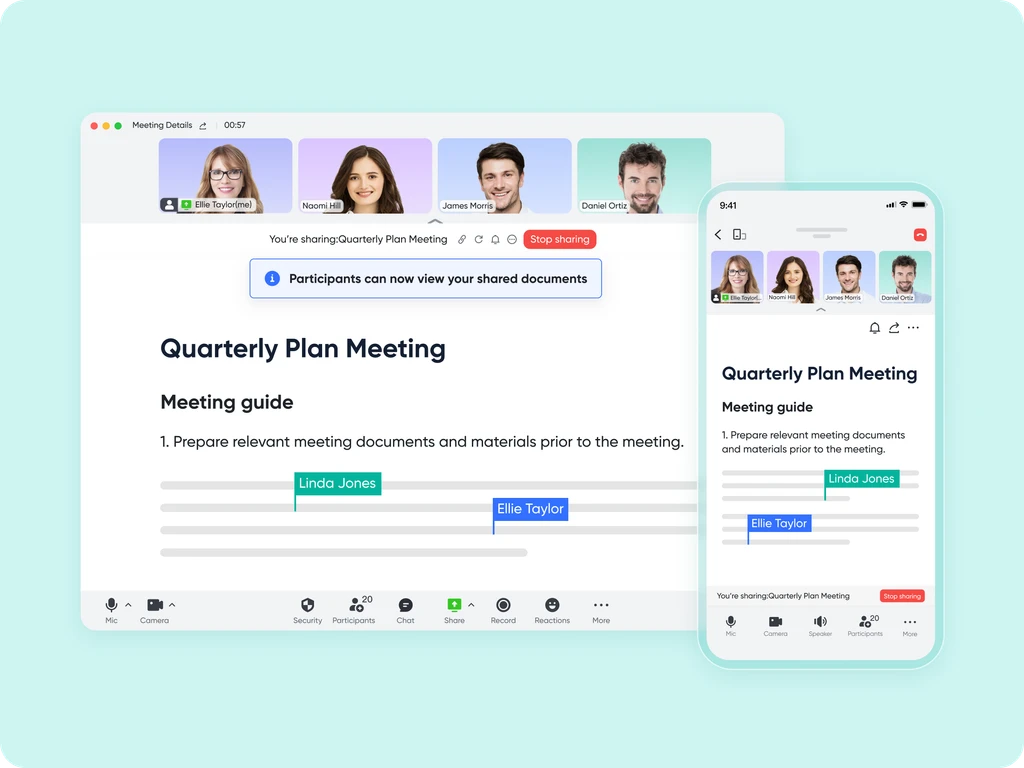
Leverage the potency of in-call document sharing, intelligent meeting minutes, and mobile-optimized features to enhance productivity collaboratively, irrespective of your location or schedule.
Seamlessly collaborate in real-time, across any device
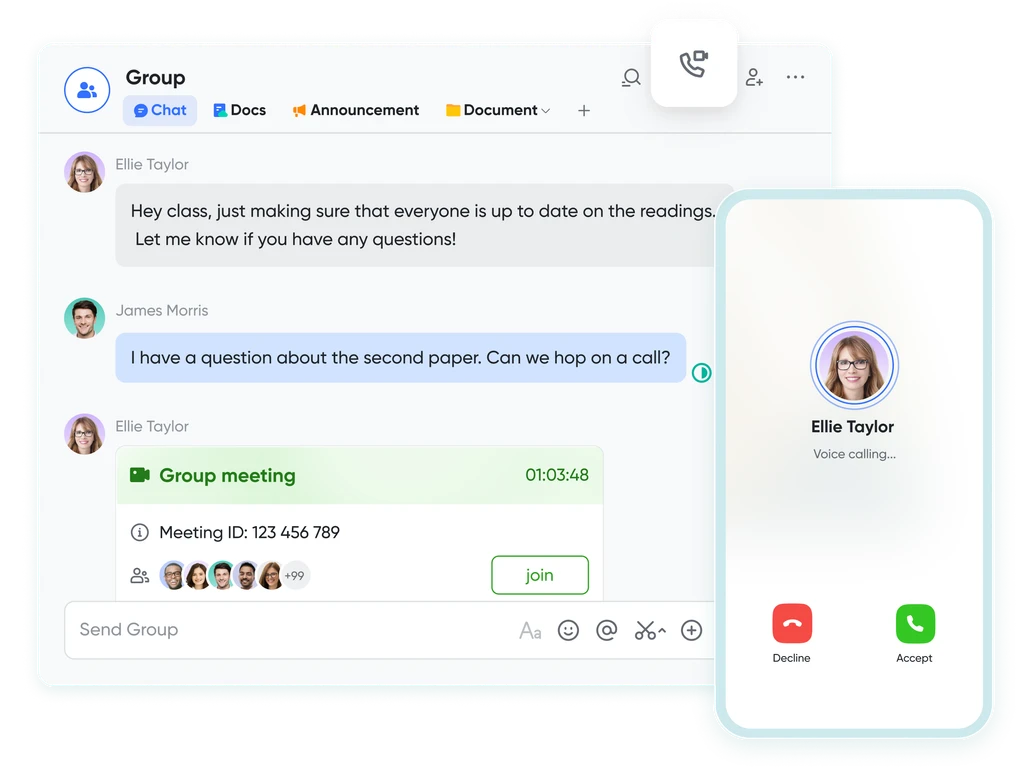
Share live documents instead of just screen views. Participants can navigate and edit simultaneously within the video call window, even while on the move.
Shift your focus to engagement, not note-taking
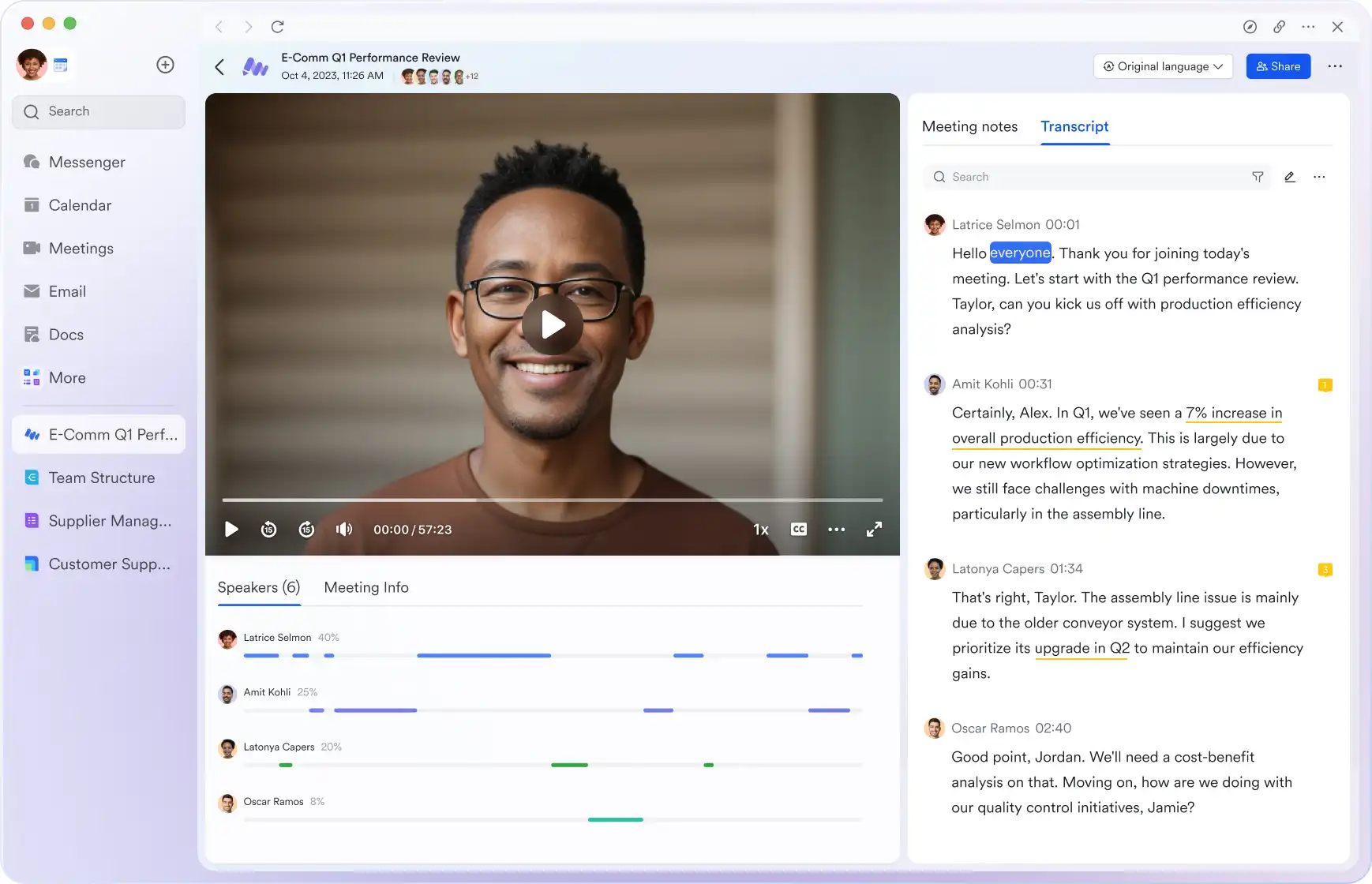
Lark Minutes automatically converts video meetings into transcripts, facilitating easy viewing, searching, and collaborative editing. Stay in the loop asynchronously, even if you can't attend the live meeting. Lark Minutes for meeting minutes support translation into 10+ different languages.
Break language barriers in communication
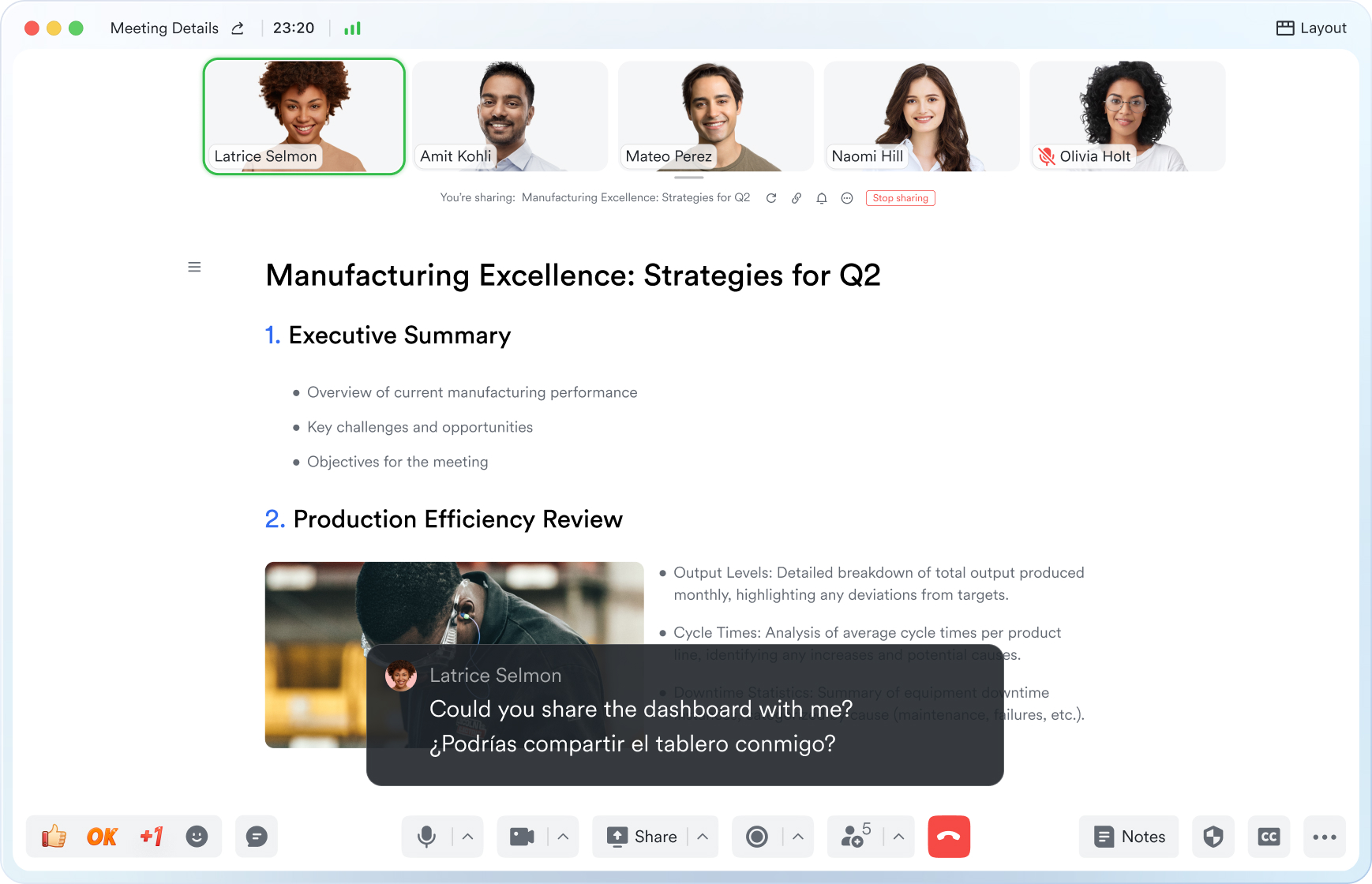
Lark Meetings provide real-time translation for subtitles, allowing individuals from diverse backgrounds to express themselves in their native languages. Ensure every voice is heard, regardless of geographical location. Live subtitles currently support translations from English, Chinese, and Japanese to 10+ different languages. See more translation feature in Lark.
Connect with larger audiences
Host dynamic online meetings and events accommodating up to 1,000 participants, with the flexibility of up to 50 breakout sessions for intimate group discussions within the larger meeting context. Try more Lark features for free.





